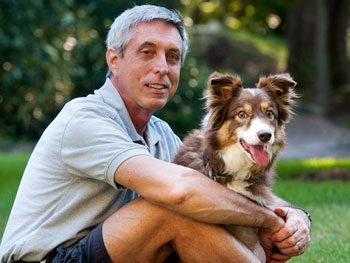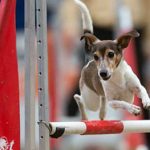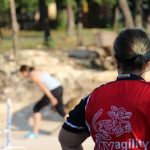Becoming an Agility Coach
Interview with Dave Grems.
I met Dave Grems at my baby dog’s first agility trial. He made an impression on me by being kind and generous with Emma, taking the time to give her treats to ease her nervousness. After a few years now, I’ve gotten to know him better as an instructor and a friend. He continues to be a wellspring of agility knowledge, always trying to offer the best solution possible in everything he does. As my coach, he has the ability to explain details that help me see the whole picture. In the interview below, he shares with us some insights into his journey from beginner agility handler to agility coach. His love of the sport of agility and positive attitude can inspire us all.
Interview with an Agility Coach: Dave Grems
Dave, When did you begin competing in agility and what led you there?
My first pure-breed border collie. Roxie came with lots of issues – no socialization skills, noise phobic, car phobic, submissive in strange places…you name it, she had it. I started taking her to Diane Smith’s Hearts & Paws Home Manners & Basic Obedience classes. When those classes finished, Diana mentioned she was thinking of starting a beginner agility class, and wondered if I’d be interested. I had no idea that by saying ‘Yes’ that agility would not only bring out the very best in Roxie, but also change my life in the process. My first competition was in May of 2000.
How and why did you start training others for agility?
I had done all I could do on my own and knew if Roxie and I were going to improve our competitive skills, we needed to get into a formal class. I had also gotten my second border collie, Josh, so I wanted to start him on the right foot as well. I started lessons with Gerry Brown in 2002 at DePaw. Under Gerry’s tutelage, both Josh and Roxie had become ‘Q’-ing machines! In 2005 everything changed. I had to retire both Roxie & Josh from agility due to different medical issues. I went from competing with two amazing dogs, to nothing. Gerry knew how much I loved agility and asked me to be a trainer at his facility so that I could keep my hand in the sport. I absolutely loved seeing agility from an instructor’s perspective, and learned so much more than from just being a student. Over the course of my 10 years teaching at DePaw, I have taught all skill levels. I can’t guess at how many dogs I’ve met and watched become agility athletes. But more importantly, I can’t begin to describe how much I’ve learned from Gerry and that great, life-changing opportunity he gave me.
What challenges have you faced along the way that may surprise people?
My greatest challenge has possibly been ‘getting out of my own head’. I am my own worst critic, and I often let disappointment overshadow my accomplishments. I think that’s why I zero in on that with students because I know first-hand how negative thinking can adversely shape perceptions and actions in both us and our dogs.
What or who has inspired you along the way?
At this point in my answers it is no surprise that Diana Smith and Gerry Brown have played important roles in my life with dogs. Diana introduced me to training through inherent behavioral actions and positive rewards. Gerry brought a perspective and discipline that I could not have achieved on my own. The trainer and handler I am today is in no small way due to what I have learned from Gerry at DePaw. The other significant person that inspires me is Shawn Cossart. She has such tremendous patience, and such a positive attitude in everything she does.
As a coach, what do you find most rewarding about teaching? alternately, most challenging?
The most rewarding thing about teaching is easy – it’s seeing handler/dog teams advance and become stars in their own right. It’s the joy when the handler or dog (or both) suddenly ‘gets something’ and achieves that hard-fought goal. The most challenging, that’s a bit harder to answer. Maybe it’s trying to find the right words to explain something, or to not lose patience when a dog and/or handler is struggling and I cannot immediately offer them a solution. I try and draw on my own struggles to find a way to help people push through a roadblock, and hope that it’s enough.
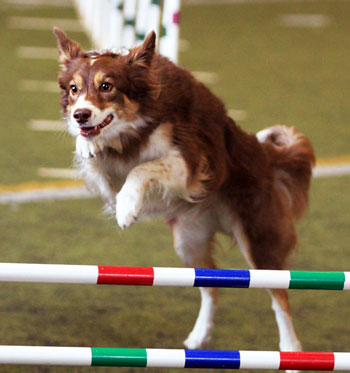
Breezing through the jumps!
What would you consider your biggest accomplishment to date?
It seems like a lot of people and their dogs just cruise right through and get the MACH or ADCH titles with ease – even multiple times before their dog is 6 or 7. But Breeze did not earn her ADCH until she was 6, and her MACH until she was almost 8. I had to retire Roxie & Josh before they earned their MACH’s, so when Breeze got her MACH, symbolically, it was like it was an achievement for all 3 dogs! And then when I received the USDAA Lifetime Achievement Award-Bronze plaque for Breeze – the same year she appeared in many top lists -that was icing on the cake. It was a long struggle for us, through lots of challenges, both training and mental. I know it’s not about the titles, it is about the journey, but those moments of recognition were truly extraordinary for me.
How do you feel the sport of dog agility has changed through the years? for the good and worse?
Some obstacle specifications have changed or been eliminated for safety concerns, but mainly I see an increase in competitiveness from handlers, and an increase in what we ask of our dogs in athleticism. I remember when agility was primarily a fun and social event. Stepping to the line with your dog had its moments of anxiety, and judging faults still had its disappointments, but most people did not seem to take agility so seriously. Today, it seems Q’ing and titles have become the primary focus. I also hear about more dog injuries, and more ring anxiety issues than before, and can’t help but think that they are related. I hope that we all are not turning this sport into an exclusively competitive event at the expense of our dog’s health and wellbeing. There is so much fun to be had, so much comradery among competitors to enjoy, so much to be appreciated of our dogs each and every time we step into the ring. Unfortunately, I have had the phrase ‘You never know when you’ll have that last run with your dog” come true, several times. I hope that we do not lose sight of those moments of joy and brilliance with our dogs because then agility would lose its special edge
What do you wish your students would take away most importantly from their lessons?
Gerry Brown once said to me, “I hope every student drives home feeling happy and like they have learned or accomplished something at each class”. Having that goal, that mission for every class really struck a chord with me. If someone walks away from one of my classes and doesn’t have that sense of accomplishment, then I’ve not brought enough inspiration, incentive, or skills/challenges to the table. I encourage people to keep trying, and keep believing in your dog, and themselves. There will always be something that’s difficult to grasp. The trick is to push beyond that perceived limitation.
What advice would you give people just starting to compete at agility trials?
First, before you are ready to compete, go to lots of trials with and without your dog. Volunteer as ring crew, become familiar and comfortable with the trial environment. That familiarity will go a long way toward easing your anxiety the first time you step into the ring with your dog. Also, you’d be surprised after watching dog after dog at how many people are not perfect in the ring – and you don’t have to be either! The most important thing is to allow your first competition experience to be fun!
In your experience, what do you think handlers struggle with the most while training and competing?
Overwhelmingly, nerves and sense of not being good enough seems to plague us all. Self-deprecation undermines our ability to succeed. We all have to remember to stay focused and be positive. It is important to see the good in our dogs and understand that they want to please us.
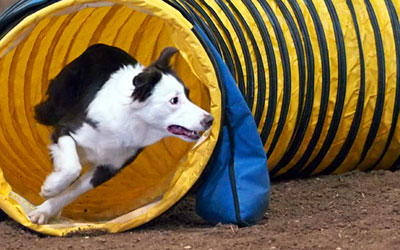 What do you hope to achieve in competition?
What do you hope to achieve in competition?
Although my new dog, Spy has his own set of challenges, I look to the day when we are competing in the Masters ring because (for me) that is where the fun is! I need to be mindful of the journey and not just the destination which is sometimes so hard to do. Long term – I hope that I can attend another national competition. I had the incredible pleasure of attending two USDAA Cynosport events with Breeze, and had the time of my life! Both were exhilarating experiences I will never forget. While a national competition is nothing more than a large local event, seeing people with their dogs from around the world is such a rush!
What would you say are your strengths as a trainer?
I think any trainer needs to have knowledge of the sport, good communication skills, good handling skills, empathy for the dog and handler team, and a positive attitude through the more challenging training sessions. I strive to make those the foundation of what I bring to the table. But where I hope to make a difference is explaining how I see both the dog and handler’s path through a course. To execute a course well, a handler needs to know when to stay with their dog and when they can leave their dog. It’s helpful to know where and how they can cut their line short so that they can get to places on a course to handle those more challenging elements. It’s important to understand how motion, direction, and general body language influences a dog’s path. Many instructors just talk about physical handling skills, how to get tight turns, what commands to give and when. But there are so many other nuances that can make or break a run. I try and present options that can optimize both the handler and a dog’s lines. I strive to explain those options to my students, and help them understand the skills they need to get there.
How do you mentally prepare for a run or manage nerves at a trial during a run?
I try to plan my course long before our 8 minute walkthrough starts. I’ll study a course map, getting ideas on what I think I want to do. If possible, I’ll then ‘walk the course’ from as many edges of the ring as possible. I rarely watch other competitor runs because different height dogs have different challenges on the same course. During my actual walkthrough, I’ll walk the course one or two times just for flow. Then, I’ll start working on my cues. Where do I want to execute crosses, and what kind? Between what obstacles? Physically, where do I want to start a cross, where on the course do I want to focus my motion, where do I want to accelerate and decelerate? When I do any kind of cross, I’ll look for ‘landmarks’ – jump stanchions, corners of contact obstacles, anything that is stationary where I can set a line, then re-walk my course with those ‘bearings’ in mind. Then when I run, I concentrate on one obstacle at a time, looking for those bearings that I established, and be mindful of my motion cues.
To manage any nervousness, I try to go into a bubble with my dog, blocking out anything around me that does not matter. I try to imagine the course a dog or two ahead of me. Then when it’s our turn to walk through the gate, I take a breath, live in the moment, block out everything outside of the ring.
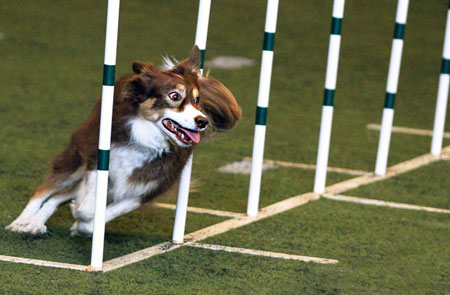
Weaves are a Breeze!
What lessons have you learned from different dogs you’ve owned/trained through the years?
I’ve related to each and every one of my dogs differently. I try and allow them to have their own personalities and quirks, that’s part of what makes them special. I’ve tried to be patient with them, and not demand too much too quickly. Breeze and I understood each other from the get-go. Spy is different, he is much more independent than Breeze, and I’ve had to approach working with him differently. He gets frustrated quicker, and if he doesn’t get something right away, he stops paying attention to me and just starts guessing. The biggest thing I’ve learned is that dogs are a lot like people. You just have to develop a unique relationship with each one and appreciate them for who they are.
What has been the biggest help to you in your competition journey?
I guess I’d have to say patience. Every dog I’ve competed with, whether they have been mine or someone else’s, has had their challenges. Some have been mental/emotional, some have been physical, but all learn/interpret instruction differently. I try to not set any expectations or time limits on training something, but to just keep changing approaches, until the effort pays off. Titles and awards have not come easy for any of my dogs, and it would have been all too easy to just give up, as frustrating as it was sometimes. But I love the sport of agility too much, and my dogs mean too much to me to give up on them simply because they did not achieve something in the timeframe I would have liked.
Tell us about your program you developed?
My day job was developing and supporting medical billing software, specifically (hospital) acute care. I am very used to dealing with numbers and complex processes. I had some ‘time off work’ in 2004, and things had started to get complicated competing with 2 dogs. I had a spreadsheet I was using to keep track of Roxie & Josh’s competition results and titles, but it was getting too complex to maintain. I figured with my background in software development that I could come up with something that was easy to use, supported multiple dogs and multiple venues. After a few months of prototyping, Agility Trial Journal (ATJ) came to be. I formed Flat Creek Studios in 2005, and a few months later started marketing the software via Clean Run magazine. Over the last 11 years, I have released over 30 updates, and continue to enhance and support the product for customers in nearly all 50 states. ATJ supports competition results for AKC, ASCA, CPE, DOCNA, NADAC, and USDAA.
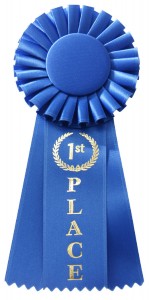 Where can we purchase?
Where can we purchase?
You can find more information about Agility Trial Journal on my website – Flat Creek Studios. I firmly believe in the ‘try before buy’ philosophy, so you can download a fully-functional evaluation copy that you can use free for 30 days (after installation and 1st use). If you like it, go back to the website and purchase a license. The way the purchasing works is that you buy the base software, and add support for the individual venues that you trial in. I did this primarily to keep individual license costs down.
ATJ is different from other products in that you can not only keep track of your runs and titling information (it has full titling rules built in, so you don’t even have to know what you need for any given title), but you can track progress, Q rates, and certain performance statistics. It will produce your AKC (and some other) entry forms, keep track of hotel reservations, allow you to link scans of course maps for notation, as well as link other files such as premiums and video.
Click Here to Download the trial version of Agility Trial Journal Software
Contact David Grems for current schedule of classes at HOT Dog Sports in Dripping Springs, Texas

